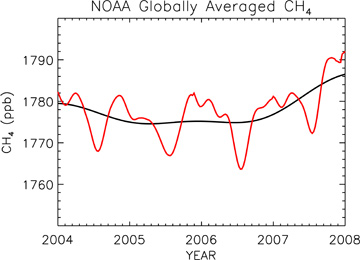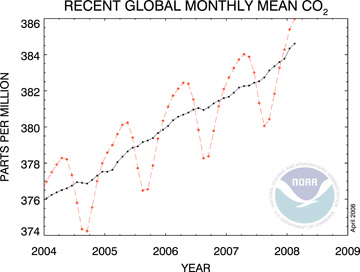Carbon dioxide, methane levels rise sharply in 2007
Carbon dioxide, methane levels rise sharply in 2007
mongabay.com
April 23, 2008
|
|
Atmospheric concentrations of carbon dioxide and methane — potent greenhouse gases — rose sharply in 2007, according to NOAA.
The U.S. weather agency said that global levels of carbon dioxide, the primary driver of global climate change, climbed by 0.6 percent, or 19 billion tons in 2007. Methane levels increased by 27 million tons after nearly a decade with little or no increase.
NOAA said that atmospheric CO2 levels currently stand at 385 parts-per-million, or about 38 percent higher than pre-industrial levels. It noted that the rise in CO2 concentrations has been accelerating since the 1980s when annual increases were around 1.5 ppm per year. Last year the increase was 2.4 ppm.
On the other hand, the increase in methane levels is a relatively new trend. Emissions had been flat since 1998.
 Global methane (CO4) concentrations rose in 2007. The red line shows the trend together with seasonal variations. The black line indicates the trend that emerges when the seasonal cycle has been removed. (Credit: NOAA) |
NOAA attributed the rise in methane emissions to rapid industrialization in Asia and higher emissions from peatlands in the Arctic and the tropics.
Methane is produced by both human activities and natural causes. About one-third of methane emissions come from oceans, wetlands, wildfires, and termites, while two-thirds from the production of oil and natural gas, mining, sewage and decomposition of garbage, changes in land use and deforestation, and livestock.
Billions of tons of methane are locked up in Arctic tundra and as frozen hydrate deposits in the deep oceans. Researchers are concerned that as the planet warms, these deposits could destabilize, releasing large methane emissions.
“We’re on the lookout for the first sign of a methane release from thawing Arctic permafrost,” said Ed Dlugokencky, a scientists with NOAA’s Earth System Research Laboratory. “It’s too soon to tell whether last year’s spike in emissions includes the start of such a trend.”
 The 2007 rise in global carbon dioxide (CO2) concentrations is tied with 2005 as the third highest since atmospheric measurements began in 1958. The red line shows the trend together with seasonal variations. The black line indicates the trend that emerges when the seasonal cycle has been removed. (Credit: NOAA) |
Scientists say hydrate deposits may have played an important role in past climate change by causing fluctuations in atmospheric concentrations of greenhouse gases. For example, the rapid decomposition of frozen methane hydrate deposits, possibly a result of higher ocean temperatures, may have been responsible for the sharp spike in atmospheric concentrations of greenhouse gases during the Palaeocene/Eocene thermal maximum (PETM) — a period of rapid, extreme global warming about 55 million years ago. The methane released during melting would have reacted with oxygen to produce huge amounts of carbon dioxide. The warming caused a mass extinction among marine animals and helped usher in the “Age of Mammals.”
Most methane emissions never reach the atmosphere — they are broken down by ultraviolet radiation. For methane that does reach the atmosphere, the gas has a lifetime of about eight years. In contrast, carbon dioxide can last a century in the atmosphere. As such, atmospheric methane levels can be quickly reduced, while carbon dioxide accumulates and presents a long-term problem. Still, methane levels have more than doubled since the beginning of the Industrial Revolution in the 18th century. With twenty five times more heat-trapping potential than carbon dioxide, methane’s overall climate impact is nearly half that of carbon dioxide despite atmospheric concentrations of around 1,800 parts-per-billion.
Meanwhile at 385 ppm, present carbon dioxide levels may be significantly higher than at any point in the last 650,000 years, according to research published in 2005 in the journal Science. The Intergovernmental Panel on Climate Change (IPCC) projects that atmospheric carbon dioxide levels could reach 450-550 ppm by 2050, resulting in higher temperatures and rising sea levels.
Environmenalists have recently launched a campaign targeting a global CO2 concentration of 350 ppm, a level which they say will avoid the worst impacts of global warming.